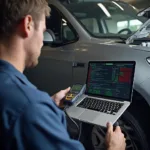OBD2 PID definitions are crucial for anyone working with vehicle diagnostics. They are the keys to unlocking the wealth of information hidden within your car’s computer. Understanding these definitions allows you to pinpoint issues, optimize performance, and gain a deeper understanding of your vehicle’s inner workings. This article dives deep into the world of OBD2 PIDs, exploring their importance, how to use them, and providing valuable resources for further learning. obd2 scan codes list
Decoding the Secrets: What are OBD2 PID Definitions?
OBD2, or On-Board Diagnostics II, is a standardized system that allows external devices to access diagnostic information from a vehicle’s computer. PIDs, or Parameter IDs, are codes that represent specific data points within that system. Each PID corresponds to a particular piece of information, such as engine speed, coolant temperature, or fuel pressure. Knowing the obd2 pid definitions is essential for interpreting the data retrieved by an OBD2 scanner.
Think of it like this: your car’s computer speaks a complex language. OBD2 PIDs are the dictionary that translates that language into something you can understand. Without the dictionary (the PID definitions), the data is meaningless.
Why are OBD2 PID Definitions Important?
Understanding obd2 pid definitions is paramount for several reasons:
- Accurate Diagnostics: Knowing which PIDs correspond to which parameters allows you to quickly identify the source of a problem. Instead of guessing, you can pinpoint the specific sensor or system that is malfunctioning.
- Enhanced Performance Tuning: For car enthusiasts, access to real-time data through PIDs can be invaluable for performance tuning. Monitoring parameters like air/fuel ratio and ignition timing allows for precise adjustments and optimization.
- Preventive Maintenance: Tracking data over time can help identify potential issues before they become major problems. For example, monitoring coolant temperature can alert you to a developing leak in the cooling system.
- Improved Fuel Efficiency: By monitoring fuel consumption and other relevant parameters, you can identify driving habits or mechanical issues that are impacting fuel economy.
How to Use OBD2 PID Definitions
Using obd2 pid definitions effectively requires a few key steps:
- Obtain an OBD2 Scanner: A quality OBD2 scanner is essential for retrieving data from your vehicle.
- Find a Reliable PID Database: Numerous online resources provide comprehensive lists of OBD2 PIDs and their corresponding definitions.
- Identify the Relevant PIDs: Based on the issue you’re investigating or the data you’re looking for, identify the specific PIDs you need.
- Connect the Scanner and Retrieve Data: Connect the scanner to your vehicle’s OBD2 port and use the software to request data from the selected PIDs.
- Interpret the Data: Using the PID definitions, interpret the data displayed by the scanner to understand what’s happening within your vehicle.
Common OBD2 PID Definitions
While the complete list of OBD2 PIDs is extensive, some commonly used ones include:
- Engine RPM: Indicates the engine’s speed in revolutions per minute.
- Vehicle Speed: Shows the vehicle’s speed in kilometers or miles per hour.
- Coolant Temperature: Measures the temperature of the engine coolant.
- Intake Air Temperature: Indicates the temperature of the air entering the engine.
- Fuel Pressure: Measures the pressure of the fuel being delivered to the engine.
“Accurate interpretation of OBD2 PIDs is paramount for effective diagnostics,” says automotive expert John Smith, a certified mechanic with over 20 years of experience. “Understanding these definitions can save you time and money by allowing you to quickly identify the root cause of a problem.” honda civic obd2
Advanced OBD2 PID Usage
Beyond basic diagnostics, obd2 pid definitions can be used for more advanced applications:
- Data Logging: Recording data from multiple PIDs over time can reveal trends and patterns that may not be apparent from a single snapshot.
- Custom PID Development: For specific applications, custom PIDs can be developed to access unique data points within a vehicle’s system.
- Integration with Other Systems: OBD2 data can be integrated with other systems, such as fleet management software, to provide comprehensive vehicle monitoring.
Conclusion
OBD2 PID definitions are the Rosetta Stone of vehicle diagnostics. By understanding these definitions, you gain the ability to unlock a wealth of information about your vehicle’s performance, health, and potential issues. From simple diagnostics to advanced performance tuning, the power of OBD2 lies in the accurate interpretation of these crucial codes. Remember to always consult a reliable PID database for the most up-to-date information and interpretations of obd2 pid definitions. d plug obd2 civic
FAQ
- Where can I find a complete list of OBD2 PID definitions?
- What type of OBD2 scanner do I need to access PIDs?
- Are all OBD2 PIDs supported by all vehicles?
- Can I use OBD2 PIDs to clear trouble codes?
- How often should I monitor OBD2 data?
- Can I use OBD2 PIDs for emissions testing?
- Are there any safety precautions I should take when using an OBD2 scanner?
“Leveraging OBD2 data and understanding the corresponding PIDs can be transformative for vehicle maintenance,” adds automotive engineer Jane Doe, specializing in vehicle diagnostics for over 15 years. “It empowers owners with valuable insights into their vehicles’ operation and can significantly contribute to preventative maintenance and informed decision-making.”
Troubleshooting Common Issues with OBD2 PIDs
Here are a few common scenarios and how to address them:
- Scanner Not Reading Data: Ensure the scanner is compatible with your vehicle and that the connection to the OBD2 port is secure. what year vehicles does obd2 code reader cover
- Incorrect Data Displayed: Double-check the PID definitions and ensure you are requesting the correct parameter.
- Intermittent Data Loss: Check for loose wiring or a faulty OBD2 port.
Further Reading and Resources
- Check out our article on obd2 check engine light flashing for more information on diagnosing engine problems.
Need help with your car diagnostics? Contact us via WhatsApp: +1(641)206-8880, Email: [email protected] or visit us at 789 Elm Street, San Francisco, CA 94102, USA. Our 24/7 customer support team is here to assist you.


